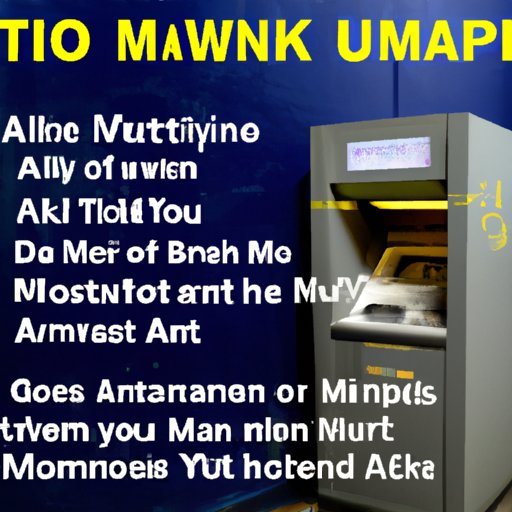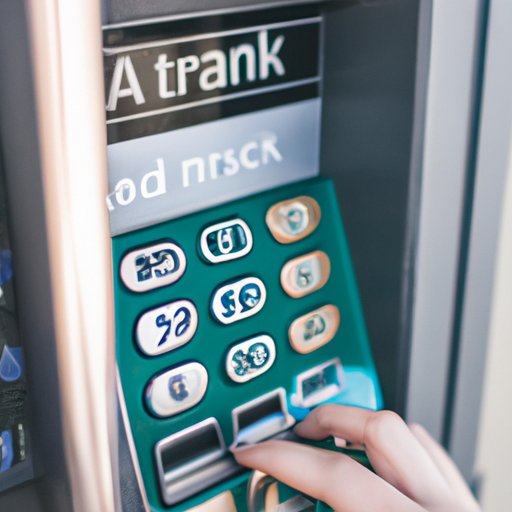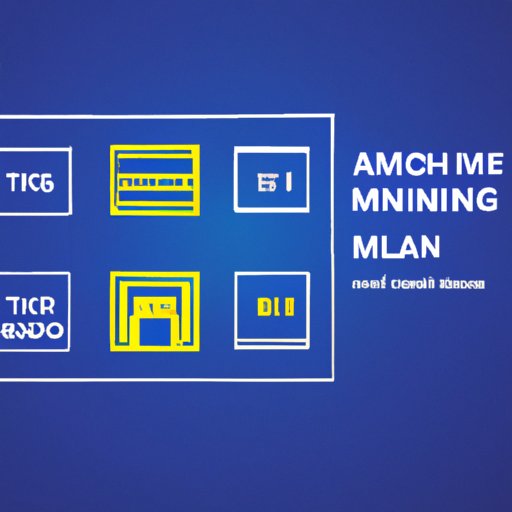Introduction
Automated Teller Machines (ATMs) are a staple of modern banking, allowing customers to conveniently access their funds at any time of the day or night. While most people are familiar with the basics of withdrawing cash from an ATM, many do not realize that there are certain limits in place when it comes to how much money they can take out. Understanding these limits and fees is important for making sure that you always have enough cash on hand when you need it.
Exploring ATM Withdrawal Limits: How Much Money Can You Take Out of an ATM?
When it comes to ATM withdrawals, there are several different factors that come into play. Different types of ATMs may have different withdrawal limits, and banks often have their own specific rules and regulations regarding how much money you can take out from an ATM. In addition, many ATM networks also impose their own limits as well. Let’s take a closer look at each of these factors.
Different Types of ATMs
The type of ATM that you use can have a major impact on the amount of money that you can withdraw at one time. For example, some ATMs are located inside banks, while others are stand-alone machines located outside of banks. Bank-owned ATMs typically have higher withdrawal limits than stand-alone ATMs, so if you need to take out a large sum of money all at once, it is usually better to visit a bank-owned ATM.
Bank-Specific Withdrawal Limits
Most banks have their own specific withdrawal limits in place for their customers. These limits vary from bank to bank and can range from $200 per day to $1,000 per day or more. Before attempting to make a large withdrawal from an ATM, it is important to check with your bank to find out what their specific limit is. This will help ensure that you don’t end up being turned away from the machine because you have exceeded the maximum withdrawal amount.
ATM Network Withdrawal Limits
In addition to bank-specific limitations, many ATM networks also impose their own limits on how much money you can take out of an ATM. These limits are usually much lower than the bank-specific limits, and they tend to be around $300 to $500 per transaction. It is important to keep in mind that even if your bank allows you to take out more money than this, the network limit may still apply.

How to Maximize Your ATM Withdrawal Amounts
There are several steps that you can take to make sure that you get the most out of your ATM withdrawals. Here are a few tips for maximizing your withdrawal amounts:
Understanding Your Bank’s Policies
The first step is to make sure that you understand your bank’s policies regarding ATM withdrawals. Knowing the exact amount that you are able to withdraw each day will help you plan ahead and make sure that you don’t run into any problems when you try to take out cash.
Checking Your Account Balance
Before attempting to make a large withdrawal from an ATM, it is important to check your account balance to make sure that you have enough money in your account to cover the withdrawal. This will help you avoid any potential overdraft fees or other problems that could arise from attempting to withdraw more money than you actually have.
Utilizing Multiple ATM Networks
Many banks and credit unions are part of multiple ATM networks. If you need to take out a large amount of cash, it is often possible to take advantage of this by using different ATMs associated with different networks. This can allow you to bypass the network-imposed limits and get more cash out in a single transaction.

Navigating ATM Withdrawal Limitations: What You Need to Know
In addition to withdrawal limits, it is also important to understand the various fees and other restrictions that can affect how much money you can take out of an ATM. Let’s take a look at some of the most common fees and maximums that you should be aware of.
ATM Fee Structures
Many banks charge a fee for using an ATM, and these fees can vary depending on the type of ATM that you use. For example, some banks may charge a flat fee for all transactions, while others may charge a percentage of the amount withdrawn. It is important to be aware of any fees that may be associated with using an ATM so that you can factor them into your overall cost.
Other Factors That Affect Your Withdrawal Limits
Your bank may also impose other restrictions on how much money you can take out of an ATM. For example, some banks may limit the number of withdrawals that you can make in a given period of time, or they may require that you provide additional identification when making larger withdrawals. Be sure to read through your bank’s terms and conditions to understand any other limitations that may be in place.

Making the Most of Your ATM Withdrawal: Tips for Getting the Most Cash Out
Once you understand the various limits and fees associated with ATM withdrawals, there are a few things that you can do to make sure that you get the most out of your cash. Here are a few tips for getting the most cash out of an ATM:
Consider Shopping Around for ATMs
If you need to take out a large amount of cash, it is often worth it to shop around for ATMs that offer higher withdrawal limits or lower fees. Comparing the different options available can help you save money and ensure that you get the most out of your ATM withdrawals.
Use Online Banking Tools
Many banks now offer online banking tools that allow you to track your account balance and view recent transactions. Utilizing these tools can help you stay on top of your finances and make sure that you never exceed your withdrawal limits.
Utilize Mobile Apps
Many banks now also offer mobile apps that you can use to make ATM withdrawals. These apps can be a great way to quickly and easily access your funds without having to go to an actual ATM. Just be sure to check your bank’s app store listing to make sure that the app is compatible with your device.
Understanding ATM Withdrawal Fees and Maximums: What You Need to Know
Knowing the various fees and maximums associated with ATM withdrawals is essential for getting the most out of your cash. Here is a quick overview of some of the most common ATM fees and maximums that you should be aware of:
ATM Fees
Most banks charge a fee for using an ATM, and these fees can vary depending on the type of ATM that you use. Be sure to check with your bank to find out what their specific fees are.
Daily Withdrawal Limits
Most banks have their own daily withdrawal limits in place, which can range from $200 to $1,000 or more. It is important to check with your bank to find out exactly what their limit is.
Other Limitations
Your bank may also impose other restrictions on how much money you can take out of an ATM. Be sure to read through your bank’s terms and conditions to understand any other limitations that may be in place.
Conclusion
Withdrawing money from an ATM can be a convenient way to access your funds, but it is important to understand the various limits and fees that can affect how much money you can take out. By following the tips outlined in this article, you can make sure that you always get the most out of your ATM withdrawals.
(Note: Is this article not meeting your expectations? Do you have knowledge or insights to share? Unlock new opportunities and expand your reach by joining our authors team. Click Registration to join us and share your expertise with our readers.)
